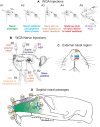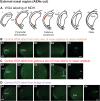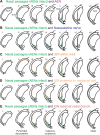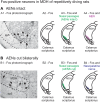Innervation of the Nose and Nasal Region of the Rat: Implications for Initiating the Mammalian Diving Response
- PMID: 30483070
- PMCID: PMC6243009
- DOI: 10.3389/fnana.2018.00085
Innervation of the Nose and Nasal Region of the Rat: Implications for Initiating the Mammalian Diving Response
Abstract
Most terrestrial animals demonstrate an autonomic reflex that facilitates survival during prolonged submersion under water. This diving response is characterized by bradycardia, apnea and selective increases in peripheral vascular resistance. Stimulation of the nose and nasal passages is thought to be primarily responsible for providing the sensory afferent signals initiating this protective reflex. Consequently, the primary objective of this research was to determine the central terminal projections of nerves innervating the external nose, nasal vestibule and nasal passages of rats. We injected wheat germ agglutinin (WGA) into specific external nasal locations, into the internal nasal passages of rats both with and without intact anterior ethmoidal nerves (AENs), and directly into trigeminal nerves innervating the nose and nasal region. The central terminations of these projections within the medulla were then precisely mapped. Results indicate that the internal nasal branch of the AEN and the nasopalatine nerve, but not the infraorbital nerve (ION), provide primary innervation of the internal nasal passages. The results also suggest afferent fibers from the internal nasal passages, but not external nasal region, project to the medullary dorsal horn (MDH) in an appropriate anatomical way to cause the activation of secondary neurons within the ventral MDH that express Fos protein during diving. We conclude that innervation of the anterior nasal passages by the AEN and nasopalatine nerve is likely to provide the afferent information responsible for the activation of secondary neurons within MDH during voluntary diving in rats.
Keywords: afferent pathways; anterior ethmoidal nerve; diving response; nasal cavity; nasopalatine nerve; nose; spinal trigeminal nucleus; trigeminal nerve.
Figures













Similar articles
-
Restoration of the nasopharyngeal response after bilateral sectioning of the anterior ethmoidal nerve in the rat.Physiol Rep. 2018 Aug;6(15):e13830. doi: 10.14814/phy2.13830. Physiol Rep. 2018. PMID: 30105807 Free PMC article.
-
Unmyelinated fibers of the anterior ethmoidal nerve in the rat co-localize with neurons in the medullary dorsal horn and ventrolateral medulla activated by nasal stimulation.Brain Res. 2009 Nov 17;1298:131-44. doi: 10.1016/j.brainres.2009.08.077. Epub 2009 Sep 2. Brain Res. 2009. PMID: 19732757 Free PMC article.
-
The anterior ethmoidal nerve is necessary for the initiation of the nasopharyngeal response in the rat.Brain Res. 2006 Feb 23;1075(1):122-32. doi: 10.1016/j.brainres.2005.12.112. Epub 2006 Feb 7. Brain Res. 2006. PMID: 16466647
-
The physiology of the nose.Clin Chest Med. 1986 Jun;7(2):159-70. Clin Chest Med. 1986. PMID: 3522066 Review.
-
Effect of neonatal capsaicin and infraorbital nerve section on whisker-related patterns in the rat trigeminal nucleus.J Comp Neurol. 1997 Sep 8;385(4):599-615. doi: 10.1002/(sici)1096-9861(19970908)385:4<599::aid-cne6>3.0.co;2-z. J Comp Neurol. 1997. PMID: 9302107 Review.
Cited by
-
Paraventricular Nucleus V1a Receptor Knockdown Blunts Neurocardiovascular Responses to Acute Stress in Male Rats after Chronic Mild Unpredictable Stress.Physiol Behav. 2022 Sep 1;253:113867. doi: 10.1016/j.physbeh.2022.113867. Epub 2022 Jun 2. Physiol Behav. 2022. PMID: 35661787 Free PMC article.
-
Direct prion neuroinvasion following inhalation into the nasal cavity.mSphere. 2024 Dec 19;9(12):e0086324. doi: 10.1128/msphere.00863-24. Epub 2024 Nov 29. mSphere. 2024. PMID: 39611853 Free PMC article.
-
Photoactivation of olfactory sensory neurons does not affect action potential conduction in individual trigeminal sensory axons innervating the rodent nasal cavity.PLoS One. 2019 Aug 14;14(8):e0211175. doi: 10.1371/journal.pone.0211175. eCollection 2019. PLoS One. 2019. PMID: 31412038 Free PMC article.
-
Asthma, classical conditioning, and the autonomic nervous system - a hypothesis for why children wheeze.Arch Dis Child. 2024 May 17;109(6):462-467. doi: 10.1136/archdischild-2023-325441. Arch Dis Child. 2024. PMID: 37648401 Free PMC article. Review.
-
Vagal Afferent Processing by the Paratrigeminal Nucleus.Front Physiol. 2019 Aug 28;10:1110. doi: 10.3389/fphys.2019.01110. eCollection 2019. Front Physiol. 2019. PMID: 31555145 Free PMC article. Review.
References
LinkOut - more resources
Full Text Sources
Miscellaneous

